
Naming every expedition participant in a telepresence-enabled mission is next to impossible! Many from dozens of institutions across the country have provided input into the expedition plan and are expected to participate. However, we've assembled information about the members of the team who are physically onboard NOAA Ship Okeanos Explorer.
And of course, none of this exploration would be possible without the work of the dedicated NOAA Commissioned Officer Corps and civilians who operate NOAA Ship Okeanos Explorer as part of NOAA's fleet managed by NOAA's Office of Marine and Aviation.
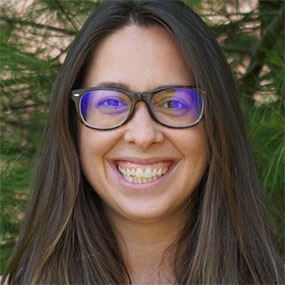
Expedition Coordinator/Mapping Lead, NOAA Office of Ocean Exploration and Research
Leg 1
Shannon Hoy is a Mapping Lead with the NOAA Office of Ocean Exploration and Research (OER). She has always had a love of the ocean and pursued a degree in marine biology from the College of Charleston, where she was first introduced to seafloor mapping in 2009. During her undergraduate career, she participated with four seafloor mapping expeditions, allowing her to increase her seafloor mapping knowledge and skills, make valuable connections, and travel to exotic places such as Indonesia and Antarctica. Two of these expeditions were actually aboard NOAA Ship Okeanos Explorer in 2010! After completing her undergraduate degree, Shannon spent the next few years gaining as much multidisciplinary ocean experience as possible. She worked for the U.S. Geological Survey’s Submarine Geohazards Group in Woods Hole, as well as University of Bristol’s Paleoceanography group in the United Kingdom. She continued to map throughout these years, and began specializing in habitat mapping using high-resolution techniques (such as remotely operated vehicle mounted multibeam), seamlessly combining her three disciplines: marine biology, geology, and seafloor mapping. In 2015, Shannon began pursuing her Master’s degree in Ocean Mapping at the University of New Hampshire’s Center for Coastal and Ocean Mapping, with the aim to increase her theoretical acoustic and geodetic background. Towards the end of her graduate degree, she jumped at the opportunity to join the OER team as a Mapping Lead, as being an OER Explorer-in-Training nearly a decade earlier had greatly shaped her career and allowed her to pursue her passion for ocean exploration.
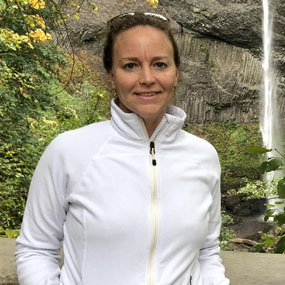
Hydrographer
Leg 1
Amanda Bittinger began her career in hydrography and mapping as a NOAA Corps Officer aboard NOAA Ship Rainier. She loves maps! She has gained 14 years of experience, working for corporate and private industry offshore and in field offices in the United States, Europe, United Kingdom, Central America, and the Central Pacific. She has worked on a wide range of hydrographic surveys and ocean mapping expeditions purposed for navigation, dredging, wind farms, seismic, pipelines, cable routes and exploration. She holds a B.S. in Oceanography and an M.S. in Oceanography, specializing in coastal zone management. Amanda was a winner in the Kongsberg calendar contest in 2017 with a water column processed image of the undersea volcano named Vailulu’u, located near American Samoa, from data acquired on NOAA Ship Okeanos Explorer. She enjoys seeing the world, especially sacred sites, and meeting new cultures. In her free time, Amanda enjoys studying the holistic nature of alternative medicines, law of attraction seminars, and energy work. She is currently pursuing a Master’s degree in Classical Chinese Medicine focusing on the five elements and Shen-Hammer pulse diagnosis, while living in Portland, Oregon.

Expedition Coordinator, NOAA Office of Ocean Exploration and Research
Leg 2
Dr. Daniel Wagner works as an expedition coordinator for the NOAA Office of Ocean Exploration and Research. Daniel has conducted fieldwork on deep-sea ecosystems since 2006 and has since spent over 500 days at sea during 25 multi-disciplinary research expeditions that explored deep-sea habitats throughout the Indo-Pacific, Atlantic, and Southern Oceans. Daniel grew up in Ecuador, where at a young age he interned at the Galapagos National Park, an experience during which he developed a deep fascination for nature and the oceans. Daniel then moved to Hawaii, where he earned a Bachelor of Science in Biology from Hawaii Pacific University, as well as a Master of Science and Ph.D. degrees in Oceanography from the University of Hawaii at Mānoa. Daniel resides in Charleston, South Carolina.
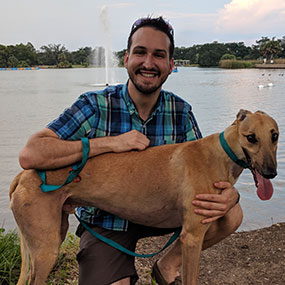
Geology Science Lead, National Research Council Postdoctoral Fellow, Naval Research Lab, Stennis Space Center, Mississippi
Leg 2
Dr. Jeff Obelcz is a geological oceanographer at the Naval Research Lab in Stennis, Mississippi. Despite being born and raised in landlocked Pennsylvania, childhood trips to the Outer Banks in North Carolina instilled a persistent curiosity about the ocean and its workings. Jeff began his formal study of the marine environment at Coastal Carolina University in Conway, South Carolina, and after graduating with a B.S. in Marine Science, he worked as a marine geologist at the U.S. Geological Survey Coastal and Marine Science Center in Woods Hole, Massachusetts. After obtaining his Ph.D. from Louisiana State University, Jeff moved to New Orleans, adopted his greyhound Fletcher, and began a postdoc at the Naval Research Lab. Jeff’s research focuses on submarine landslides, mudflows, and the environments in which such geohazards are prevalent, primarily river deltas and continental margins. These phenomena are studied through seafloor mapping, sampling, and more recently, predictive modeling via machine learning. Jeff will serve as co-science lead on this expedition, coordinating with the onshore science team and narratively interpreting the geology observed during remotely operated vehicle (ROV) dives.

Mapping Lead, NOAA Office of Ocean Exploration and Research
Leg 2
A native of Long Island, New York, Mike took a deep interest in ocean science at a young, age growing up in and on the water. After graduating from SUNY Geneseo with a degree in geological sciences, Mike continued his education at the School of Marine and Atmospheric Sciences at Stony Brook University. At Stony Brook, he worked on several projects, including acoustic mapping of coastal areas, coastal sediment management, remote sea level monitoring, submarine groundwater discharge, and applying his GIS proficiencies. Mike’s M.S. thesis focused on the processing of multibeam backscatter and its relationship to the physical characteristics of the seafloor. After completing a graduate certificate in geospatial science and earning a reputation as a reliable field scientist, Mike started a new position as a hydrographic analyst with NOAA’s Sandy Integrated Ocean and Coastal Mapping team at the Center for Coastal and Ocean Mapping (CCOM) at UNH. At CCOM Mike processed outside to NOAA hydrographic datasets, examined additional applications for topobathymetric lidar, collaborated on a seafloor imaging device, and served as a physical scientist supporting hydrographic surveys. As the newest member of the Okeanos Mapping Team, Mike is truly excited to support their mission exploring the oceans. During his off hours, Mike can be found cooking, hiking, or watching movies.

NOAA's National Center for Environmental Information
Leg 2
Dr. Barry Eakins is a marine geophysicist with the Cooperative Institute for Research in Environmental Sciences, University of Colorado at Boulder (CU), and Chief Scientist for the Coastal and Marine Geophysics Branch of NOAA’s National Centers for Environmental Information (NCEI). His current research efforts focus on analyzing seafloor morphology and researching geologic processes in support of the U.S. Extended Continental (ECS) Shelf Project and developing the documentation necessary to demonstrate U.S. ECS limits in accordance with the U.N. Convention on the Law of the Sea. He also oversees data management activities at NCEI for the NOAA Office of Ocean Exploration and Research. He served six years in the U.S. Navy, specializing in oceanography and anti-submarine warfare, before obtaining a B.A. in Geology from CU and a Ph.D. in Earth Sciences from Scripps Institution of Oceanography.
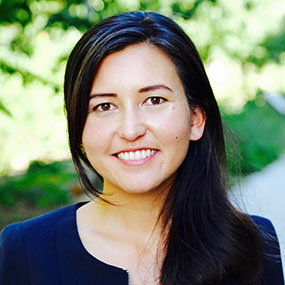
Writer/Editor, NOAA Office of Ocean Exploration and Research
Leg 2
Originally from California, Rachel earned her Bachelor of Arts in English from the University of California at Berkeley, and her Master of Environmental Management from the Yale School of Forestry & Environmental Studies. At Yale, she focused on conservation and science communication, serving as associate editor of an environmental arts magazine and the programming director of the free, public, 10-day Environmental Film Festival at Yale (EFFY). Prior to coming to the NOAA Office of Ocean Exploration and Research, she worked as an archaeology technician, outdoor educator, and researcher in Latin America, Africa, and the Pacific. With travel and work experience in over two dozen countries, she is interested in the many motivations that drive different people to care about the environment and believes that lasting conservation success depends on having an informed and invested public.

University of Hawai‘i
Leg 2
Meagan Putts is a deep-sea researcher at the University of Hawai‘i whose focus is on deep-sea coral and sponge communities. Meagan is part of an experienced team of scientists specializing in imagery analysis that most notably assembled the benthic animal guide and completed the video analysis from the 2015-2017 CAPSTONE expeditions. She also designed and maintains the Hawaii Undersea Research Laboratory (HURL) archive and is part of the team that operates the ROV Lu‘ukai. She completed her Masters in Marine Science at Hawai‘i Pacific University in Honolulu, Hawaii, and her Bachelors of Science in Marine Science and Visual Arts at Eckerd College in St. Petersburg, Florida. This will be Meagan’s fourth expedition aboard the Okeanos Explorer. She previously sailed as a science lead during the 2017 expedition Deep-sea Symphony: Exploring the Musicians Seamounts and as an Explorer-in-Training. When not in the office or at sea, Meagan enjoys surfing and creating art which often incorporates themes of deep-sea marine life.
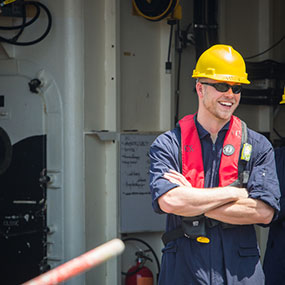
ROV Team Lead, Global Foundation for Ocean Exploration
Leg 2
Chris first joined our group on the Cayman Rise Expedition in 2011, just prior to being hired full time by NAVSEA. For the next three years, an informal NAVSEA-NOAA relationship allowed Chris to continue to participate in our design, engineering, and offshore operations. Chris holds a B.S. in Ocean Engineering and a B.S. in Aerospace Engineering from Virginia Tech with a minor in mathematics. Chris has been a major contributor to our design-build process and a tremendous asset to our offshore operations. He is a skilled navigator, pilot, and co-pilot of our vehicles and brings with him a level of enthusiasm that everyone around him appreciates and respects. In late 2014, Chris joined our Mechanical Engineering team full time and he is enthusiastic about training the next generation and tackling new projects. Chris resides in Falls Church, Virginia.

ROV Pilot / Electrical Graybeard, Global Foundation for Ocean Exploration
Leg 2
Dave Wright joined the Ocean Exploration Program in 2009 to help bring to life the ROV component aboard the Okeanos Explorer. He is a self-taught engineer who brought a set of skills that most would envy. Highly respected in the field of underwater technology, Dave spent a decade working with Dr. Robert Ballard at the Institute for Exploration. Prior to that he was a development engineer at the Monterey Bay Aquarium Research Institute. Dave is one of our senior pilots and, in addition to being an invaluable electrical engineer, he is one of our most respected mentors to the younger generation we seek to train. Dave is a veteran of some of the earlier ocean exploration projects, having served as pilot on the 2004 Titanic cruise, the 2004 and 2005 Mountains in the Sea cruises, and the 2005 cruise to Lost City. He is a co-inventor of the ‘Aquatic Autosampler,’ a fully automated system for in situ species identification of toxic phytoplankton, developed at the Monterey Bay Aquarium Research Institute. When not on assignment with Ocean Exploration, Dave enjoys exploring the brownwaters of the Ohio River near Louisville in ‘Kitty Hawk’, a 1941 mahogany-on-oak motor cruiser.
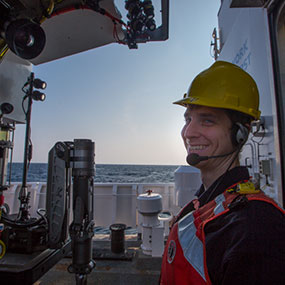
Systems/Robotics Engineer, Global Foundation for Ocean Exploration
Leg 2
Bobby Mohr is a Systems/Robotics Engineer, specializing in autonomous and remotely operated underwater vehicles. He holds a B.S. in physics and graduated cum laude from Davidson College in 2009. Bobby started his career as an engineering technician with Greensea Systems where he was responsible for the design, development, and testing of autonomous underwater vehicle control systems. Like many of our engineers, Bobby realized that he would enjoy the design-build process more if he was able to also pursue the challenges of making vehicles work successfully at sea. After serving on several projects at Greensea where he specialized in electrical and software systems support, Bobby joined the Ocean Exploration program as an electrical systems engineer. During his time at Greensea and now with NOAA, he has been one of the key electrical engineers on the development of our 6000-meter-rated remotely operated vehicle system, Deep Discoverer and Seirios. Like many of our engineers, he has multiple skills and is a tremendous asset to our program.

Global Foundation for Ocean Exploration
Leg 2
Chris Wright holds a B.S in Business Administration from the University of Mary Washington and a M.B.A from Rollins College. After graduation, he worked as a Network and Systems Administrator and Engineer in the tourism/ski resort industry in the North East and Mountain West for 15+ years. Recently relocating back to the East Coast, Chris joined the GFOE data team in early 2019 as one of the newest members to the organization. He has just completed his first open-ocean cruise aboard the Okeanos Explorer and is extremely excited about continuing the journey to explore the oceans around the world. When he isn't sailing aboard the Okeanos Explorer, he is working out of the Quonset office planning, designing and implementing data solutions to help GFOE continue to refine and mature its base of operations for ocean exploration. Chris and his family currently reside in Newport, Rhode Island.

Software/Data and Satellite Engineer - ROV Pilot/Copilot
Leg 2
Andy started his professional career in the U.S. Navy where he ran a small electronic test system calibration laboratory and instructed NATO students in Satellite Ground Station repair. Following the Navy, he obtained a B.A. in History and a M.S. in Computer Science from the University of Vermont before hiring on as the Lead Software Engineer at Greensea Systems. During his tenure at Greensea, Andy designed, developed, and supported over 40 widely varying custom robot control systems and their operator interfaces for government and industry. Notably, Andy was the software lead on our very own Deep Discoverer and Seirios remotely operated vehicles. Andy reports he so enjoyed working with the NOAA Office of Ocean Exploration and Research team, and their exploration mission, that he asked to join. Andy now splits his time between developing software; managing science and engineering data; maintaining the satellite communications system; and navigating, piloting, and co-piloting the deep-submergence vehicles. During his free time you can often find him in Monkton, Vermont.
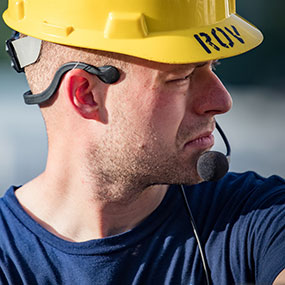
Mechanical Engineer, Global Foundation for Ocean Exploration
Leg 2
Daniel Rogers brings with him a diverse background in engineering, media production, and education. Daniel holds a B.S. in physics and received an M.S. in mechanical engineering from the University of Hawaii in 2013. His graduate work focused on the development and evaluation of an autonomous marine vessel designed for port and harbor security missions. Before starting his graduate program, Daniel worked as a science educator at the Bishop Museum in Honolulu where he continued as a digital media producer while in school. A lifelong interest in the sciences inspires him to learn all he can about the natural world and he is passionate about sharing the drama and wonder of scientific inquiry with others.
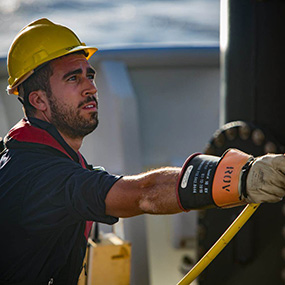
Mechanical Engineer, Global Foundation for Ocean Exploration
Leg 2
Sean Kennison holds a B.S. in Mechanical Engineering with a minor in Engineering Mechanics from Pennsylvania State University. He first sailed on the Okeanos Explorer as an intern and member of the Engineering Group, where he performed tasks associated with the launch, operation, and recovery of the ROV system. He has also worked shoreside, designing mechanical parts for the ROVs and assisting with assembly and testing of previously and newly installed equipment. Sean also assisted with installing electronics, testing, data analysis, and troubleshooting on the vehicle. Most recently, he assisted in assembling and modifying a new bio storage box for the Deep Discoverer ROV. While at Penn State, Sean served as team leader on a number of engineering design projects.
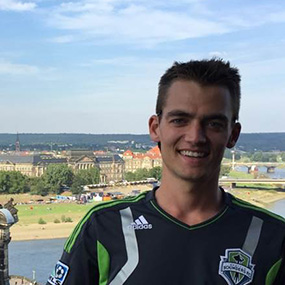
Electrical Engineer, Global Foundation for Ocean Exploration
Leg 2
Levi Unema is an Eagle Scout from Lynden, Washington. He holds a B.S. in Electrical Engineering along with a Certificate in Electric Power Engineering from Michigan Technological University. Levi has experience in a number of different industries, ranging from the railroad, to steel mills, to automotive supplier light manufacturing. Currently living in west Michigan, he enjoys being outdoors and staying active.

Ocean/Mechanical Engineer, Global Foundation for Ocean Exploration
Leg 2
Lars holds a B.S. in Ocean Engineering and a B.A. in Spanish from the University of Rhode Island. Growing up on the coast of Maine he developed a constant pull towards the unknown, the unexplored, and chaotic environments and acquired a drive to bring meaning, understanding, and order to these areas. Lars has a professional background working with autonomous underwater vehicles and other subsea robotics systems both internationally and nationally and now supports the Deep Discoverer and Seirios as an ocean/mechanical engineer.
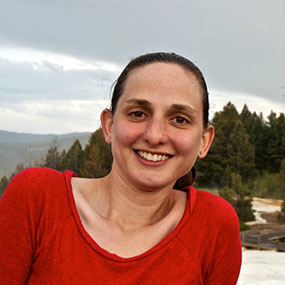
Video Producer, Global Foundation for Ocean Exploration
Leg 2
Emily Narrow is a video producer and editor whose work focuses on science and nature. She earned a Bachelor of Arts degree from Oberlin College where she double-majored in Biology and Cinema Studies. She also holds an MFA degree in Science and Natural History Filmmaking from Montana State University. She was a video producer for a production company in Washington, DC, for three years, where she made public service announcements, ad campaigns, and promotional videos for non-profit and environmental organizations. For the past six years, she has been a freelance video producer, creating videos for clients such as the National Park Service, NOAA, and Montana State University. Most recently, she produced and edited a series of educational videos about camping and hunting for Zero Point Zero Productions. Emily currently resides in Bozeman, Montana.

Video Producer, Global Foundation for Ocean Exploration
Leg 2
Caitlin Bailey holds an MFA in Science and Natural History Filmmaking from Montana State University and a B.S. in Animal Biology from Texas A&M University-Corpus Christi. Her background includes fieldwork with sea otters in Alaska, lab research on wild mice vocalizations, research on migratory bird distribution on the Texas coast, and mentoring undergraduate students in biology. She also volunteered with the Texas Marine Mammal Stranding Network and the Second Chances Wildlife Rehabilitation program at the Texas State Aquarium. In pursuit of her filmmaking career, Caitlin held a writing and film internship at NASA Goddard Space Flight Center and worked as a camera operator and stage manager with Montana PBS. Before her current position with the Global Foundation for Ocean Exploration, she discovered the amazing world of ocean exploration as a video engineering intern onboard the E/V Nautilus.

Video Engineer, Global Foundation for Ocean Exploration
Leg 2
Bob has almost 50 years’ experience in broadcast engineering. Following a 37-year career with RIPBS, departing in 2006 as Chief Engineer, he worked for the Sea Research Foundation and Ocean Exploration Trust as the Senior Broadcast Engineer. He was responsible for the design, commissioning, and maintenance of the Inner Space Center located at the University of Rhode Island Graduate School of Oceanography. He also worked on many research vessels and supported telepresence operations from NOAA Ship Okeanos Explorer, E/V Nautilus, R/V Endeavor, and R/V Atlantis, plus many other UNOLS ships. Bob is married and has six adult children, nine grandchildren, and a great-grandson. He and his wife Donna play French horn and are active in many community music ensembles in Rhode Island.

Photographer and Producer, Global Foundation for Ocean Exploration
Leg 2
For 34 years, Emmy-award winning photographer and producer Art Howard has helped viewers experience life through images from 50 countries and seven continents. A native North Carolinian, Art has followed researchers aboard multiple deep-sea missions, documenting the excitement and challenges of offshore reef exploration. Art will use the latest video technology to bring viewers as close as possible to life at sea from the surface to depths of 3,000 feet, capturing both the scientists and the life they seek to understand. Howard has spent the last 11 years independently producing media for the North Carolina Museum of Natural Sciences.
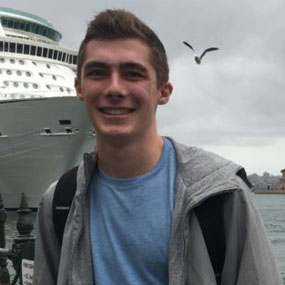
Laboratory Research Assistant, Rotjan Marine Ecology Lab
Leg 1
Jacob Jaskiel is a recent graduate from Boston University (Class of 2019), receiving a Degree with Honors in Marine Science and a minor in Environmental Analysis and Policy. He is a part of the Rotjan Marine Ecology Lab at Boston University, where he studies the dynamics of larval tunas and zooplankton in the Phoenix Islands Protected Area. Jacob has also studied the growing issue of marine plastic pollution and has published a paper on the first recorded instance of microplastics adhering to marine vascular plants. He is excited to gain more experience working at sea and looks forward to learning how to process multibeam sonar data.

Graduate Student, University of Rhode Island
Leg 1
Sky Jordan, from Ohio, is a graduate student at the University of Rhode Island, completing a Master’s in Oceanography with a focus on Ocean Data and Technology. Before graduate school, he earned a B.S. in Biology from Denison University and worked in a variety of research and technician jobs, studying everything from nesting success in Alaskan shorebirds to African monkey populations, and earning qualifications as a wildland firefighter. This eclectic set of interests led him to oceanography. He recently concluded two months aboard the scientific drill ship JOIDES Resolution, where he worked as a technician, and he is excited to explore the ocean once again. When he’s not at school, at sea, or abroad, he can be found rowing with the University of Rhode Island crew club, playing music, or hiking. Sky intends to build on this experience as an Explorer-in-Training aboard the Okeanos Explorer by pursuing a career in the NOAA Corps.
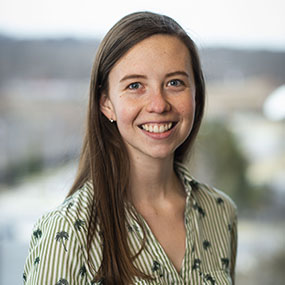
Data Manager, NOAA’s National Centers for Environmental Information
Leg 1
Anna Lienesch is a Data Manager for NOAA’s National Centers for Environmental Information (NCEI) through the University of Maryland’s Cooperative Institute for Satellite Earth System Studies (CISESS). She earned a B.S. in Marine Science with a minor in Anthropology from Eckerd College in 2016 and has been with NCEI since early 2018. Anna now serves on the data management and leadership team for the NOAA Office of Ocean Exploration and Research (OER) and acts as a liaison to various NOAA divisions. Her duties include assisting in the end-to-end data management activities for the Okeanos Explorer and other NOAA-funded ocean expeditions and ensuring the long-term preservation and access of OER’s legacy submersible videos. This will be Anna’s first expedition onboard the Okeanos Explorer, and she looks forward to learning as much as possible while out at sea.

Student, Fisheries and Marine Institute of Memorial University of Newfoundland
Leg 1
Emily Meadus currently attends the Fisheries and Marine Institute at Memorial University of Newfoundland, located in St. John’s, Newfoundland. She will be completing her fourth and final year in the Ocean Mapping program this upcoming fall. Upon graduation, she will receive a Diploma of Technology in Ocean Mapping as well as a Bachelor of Technology Degree. Recognized and accredited as both a Category B Hydrographic Surveyor Program under the International Hydrographic Organization (IHO) as well as a National Canadian Technology Accreditation Board (CTAB) Surveying and Geomatics Technologists program, the Ocean Mapping program at the Marine Institute has allowed her to become skilled in the mobilization and deployment of different hydrographic software such as multibeam sonars, side scan sonars, and LiDAR systems; and skilled in utilizing different hydrographic software such as CARIS suite, QINsy, and GIS enabled software for data post-processing. In addition, this program has also allowed her to learn how to complete different land surveys utilizing GPS techniques. Outside of school, she holds a part-time job as a cashier, and enjoys hanging out with her friends and going on hikes. She also has a passion for travelling and for learning new and exciting things every day.

Global Foundation for Ocean Exploration
Leg 1
Fernando graduated from the University of Hawaii at Manoa with a B.S. in Mechanical Engineering. During his studies, he had experience in several fields including conceptual design, aerospace research, mechanical design, robotics and software development. From these activities he was able to intern for NASA at the Jet Propulsion Laboratory, present research in a national conference, and even coauthor a technical paper in the Journal of the Astronautical Sciences. His most recent position was at the Field Robotics Laboratory (FRL) where he helped support operations, testing and software development for two unmanned surface vehicles. From his time in FRL, he discovered a true passion for development and design of robotic systems. Originally from Colombia, Fernando enjoys outdoor activities and currently resides in State College, Pennsylvania.

Systems Administrator, Global Foundation for Ocean Exploration
Leg 1
Jim Meyers attended Williams College and received a B.A. in History. He has worked in the information technology field for over 20 years, including 19 years at various positions at Sea Research Foundation, Inc. in Mystic, Connecticut. He is married with two adult children. Outside of work, he is an avid soccer fan and plans European vacations around match schedules.
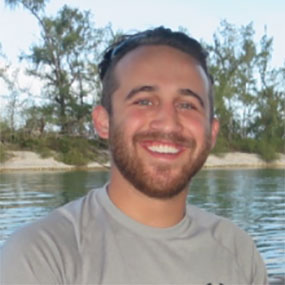
General Vessel Assistant and Marine Survey Technician, NOAA
Legs 1 & 2
Daniel Freitas is from Rochester, New York. He worked for NOAA as a General Vessel Assistant for over three years in the Augment Pool while attending Coastal Carolina University, where he studied Marine Biology and Applied Mathematics. Over the course of eight years, he worked in the deck, engineering, and survey departments aboard many NOAA vessels before taking a permanent position aboard NOAA Ship Okeanos Explorer with the Deck Department for a year and a half. For the last three years, he has been working as an Independent Contractor for UCAR aboard the Okeanos Explorer in the Survey Department. His time aboard consists of acting as a Mapping Watch Lead, helping train and direct Explorers-in-Training, and working with the Senior Survey Technician and other ship crew to ensure the ship’s missions are completed.
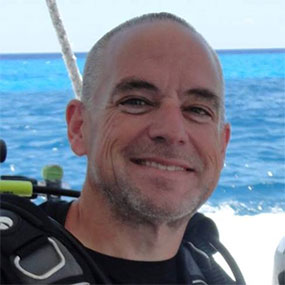
Network Systems Engineer, Global Foundation for Ocean Exploration
Legs 1 & 2
Mark holds a B.S. in Information Technology and a Masters in Computer Information Systems from Tarleton State University, where he focused on network security solutions. Mark has over 28 years experience in designing, testing, and supporting numerous variations of voice/data wired/wireless telecommunications networking solutions and security solutions, services, and products. During his career at MCI/Verizon, he held several engineering, research and development, and management positions and was with the company a combined total of over 23 years. During this time, he worked on key network projects and initiatives, including federal security solutions, access solutions, security services, virtualization, and many other large network solutions. In addition, he received four patents for networking and security solutions. Mark is married to his wife of 30 years, Laura, and has three kids and five grandkids. Some of Mark's hobbies and interests include car, truck, and boat repair/restoration; hiking, biking; running; camping; hunting; fishing; boating; amateur radio; storm chasing; home automation/security systems; fitness instructing; and scuba diving.
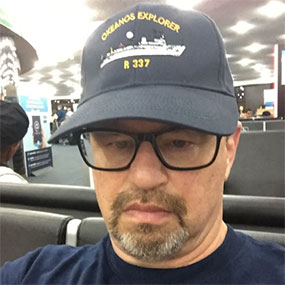
Video Engineer, Global Foundation for Ocean Exploration
Legs 1 & 2
Brian Doros is a Television Broadcast Engineer, born in Long Branch, New Jersey. Active in sports throughout high school, Brian moved to southern California spending the next few years traveling the world surfing then exploring his technical interests at college in San Diego, California. After changing his course of study to electronics, he then focused on Broadcast Electronics and Technical Maintenance in Broadcasting. His career path first led him to employment at IBM/MCA Video Laser Disc Company in Costa Mesa, California, doing research and development in the early days of optical laser disc, then to Los Angeles where he specialized in film for television post production. The next several years were spent working in the Hollywood post production industry at Paramount Pictures, MGM / Lorimar Telepictures, 20th Century Fox, NFL Films, and Sony Broadcast Company North America, contributing to his 25 years of experience in television post production and broadcast systems integration. After Hollywood, Brian worked in the field, traveling and upgrading network television facilities to digital broadcasting capabilities during the analog to digital conversion. He now has moved on to less broadcast traditional applications of his background working in his current position.